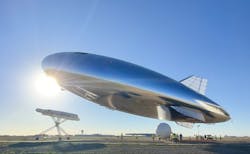Sceye's HAPS aircraft completes stratospheric diurnal flight with solar energy
ROSWELL, N.M. - Sceye, an aerospace company with a background in material science and manufacturer of High-Altitude Platform Systems (HAPS) in Moriarty, N.M., announced that it completed a full day-night flight in the stratosphere while staying over an area of operation. This shows progress toward enabling long-duration flights of months or years using solar power through daylight hours, and battery capacity enabling overnight flight through solar recharge the next morning. The HAPS launched at 7:36 AM MST on 15 August from the company's New Mexico facility and landed at 12:21 PM MST the following day after the flight test points were completed.
"This is a significant milestone for the Sceye team, towards opening up vast opportunities in the stratosphere, building an entirely new layer of infrastructure between drones and satellites," said Sceye CEO and Founder, Mikkel Vestergaard Frandsen. The ability to stay in the stratosphere for long durations over an area of operation offers a unique vantage point for detecting climate disasters in real time like wildfires and methane leaks, as well as connectivity to the billions of unconnected which conventional infrastructures cannot serve.
Sceye recent milestones include demonstrating day-night flight capabilities, controlled relocation, and the ability to remain positioned over a designated area. These accomplishments set the stage for the company to pursue commercial applications.
Related: BAE's HAPS UAS stratospheric flight powered by Amprius batteries
"The flight was an important demonstration of our platform's performance and resilience. I'm looking forward to seeing the growth and capabilities scale with each and every flight that follows," said Stephanie Luongo, Sceye's Chief of Mission Operations.
The latest flight carried a payload of advanced instruments designed to tackle global challenges. The payload included stereo-optical cameras to create precise elevation models, aiding in disaster response for events like floods and earthquakes. Infrared cameras were used to predict wildfires and detect methane leaks, two critical contributors to climate change. Additionally, the payload featured synthetic aperture radar, enabling the platform to observe vital environmental systems through clouds, in any weather, and at any time of day.
About the Author
Jamie Whitney
Senior Editor
Jamie Whitney joined the staff of Military & Aerospace Electronics in 2018 and oversees editorial content and produces news and features for Military & Aerospace Electronics, attends industry events, produces Webcasts, and oversees print production of Military & Aerospace Electronics.
